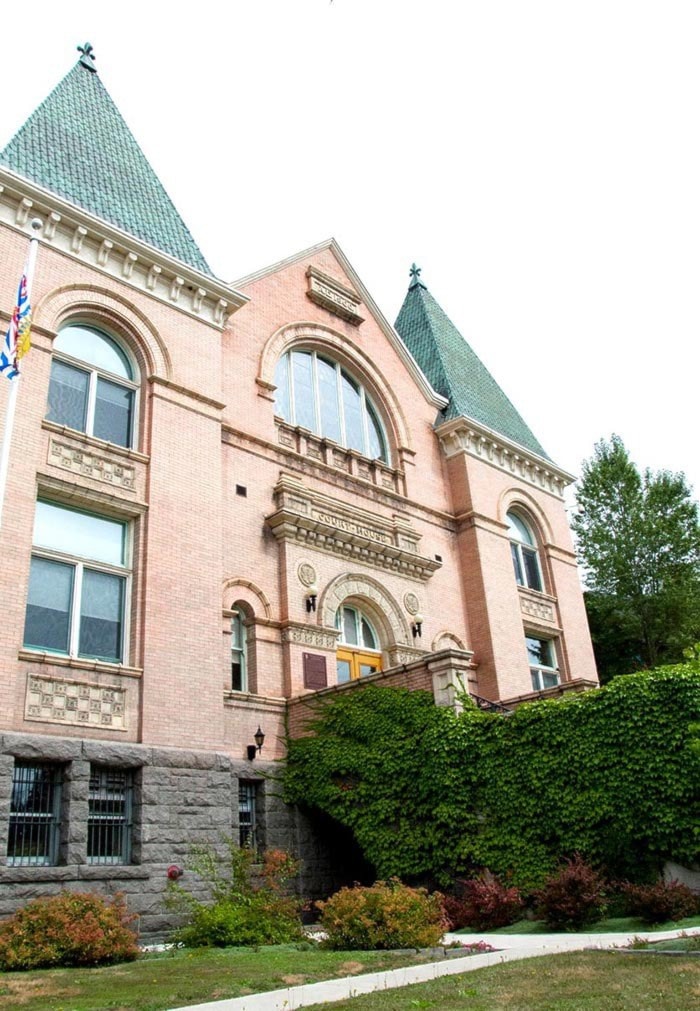Jim Sinclair
Rossland News
A pair of architectural gems, well-known and loved by Rosslanders and visitors alike, are on a list of nominees for a distinct honour. The buildings are the local courthouse and the Miners’ Hall.
A smaller list is to be compiled, made up of the top 100 buildings in the province. As you can well imagine there are plenty to choose from. Considering the number in Greater Vancouver and Victoria, for starters, it’s easy to see how 100 is not a large number when taking the whole province into account.
Ten West Kootenay Boundary buildings are in the running in the Architecture Foundation of BC’s 100 Best Buildings contest.
The foundation says the contest’s purpose is to “recognize the impact and influence that buildings have had over the past 100 years.”
The nomination period closed August 4, and now online voting is taking place. You’re allowed to cast one vote for each of four regions—Vancouver Mainland/South Coast, B.C. Interior, Islands, and Northern B.C..
Nominees could be of any age, purpose or material.
At the end of the voting on September 28, the top 25 buildings in each region will be submitted to a judging panel, who will choose the top three from each region. The winning buildings will receive award plaques.

Along with Rossland’s the niminees are:
The Langham Cultural Centre in Kaslo, built as an hotel in 1897;
Kootenay Lake Village glass house near Procter;
St. Saviour’s Anglican Cathedral in Nelson, built in 1899;
Nelson’s old Scandinavian Church, built in 1933;
Gerick’s Cycle and Ski in Nelson.
The distinctive Nelson Chrysler building.
The Gerick Cycle and Sports building in Trail;
The old schoolhouse outside Fruitvale; and,
Greenwood city hall.
To vote, go to architecturefoundationbc.ca/best-buildings-entries-for-voting.
The two Rossland hopefuls (we hope, at least) are iconic examples of how a community can identify with creations of bricks and mortar or nails and lumber.
What follows, with many thanks to Parks Canada and the Canadian Register of Historic Places, is the first of two descriptions of the history of each locally familiar building:
The Rossland Courthouse is a substantial two-storey brick building located on a steeply sloping site that affords a commanding view over the surrounding area and showcases its landmark status within the community.
The Rossland Courthouse was designated a national historic site in 1980 because it is highly representative of a distinctive regional form of Canadian court house that emerged in British Columbia during the late 19th century.
The province’s early law makers strove to emphasize the English origins of the province’s legal system in newly-settled regions in the wake of large waves of American miners and fortune seekers. Designed by Glasgow native J.J. Honeyman, Rossland’s courthouse epitomizes this approach to courthouse design through its well-preserved exterior and interior.
The key elements relating to the heritage value of this site, according to the Historic Sites and Monuments Board of Canada, include:
• the continuous function of the building as a courthouse;
• sightlines of the court house along Columbia Avenue and throughout the community which contribute to its landmark status;
• the exterior forms, massing, materials and design features of the building that contribute to its stature as an important regional landmark and as a visual symbol of authority, including:
• the roofline and roof surfaces, including tiled pyramidal corner towers, finials, cupola, semi-elliptical dormers, gabled parapets;
• original exterior brick and stone wall surfaces, including cut rubble stone basement, brick walls with polychromatic detailing in cut and carved stone and brick;
• original doors and windows;
• symmetrical floor plan, notably second floor configuration containing main court room, judges chambers, barristers room, law library, sheriff’s office and smaller courtroom;
• original interior walls, ceiling and floor surfaces and door and window surrounds;
• courtroom and subsidiary chambers, including original fixtures, stained glass windows, wall and ceiling panelling, timber beamed ceiling with inlaid cedar panels;
• central hall with imposing main staircase with ornate newel posts and railings.
